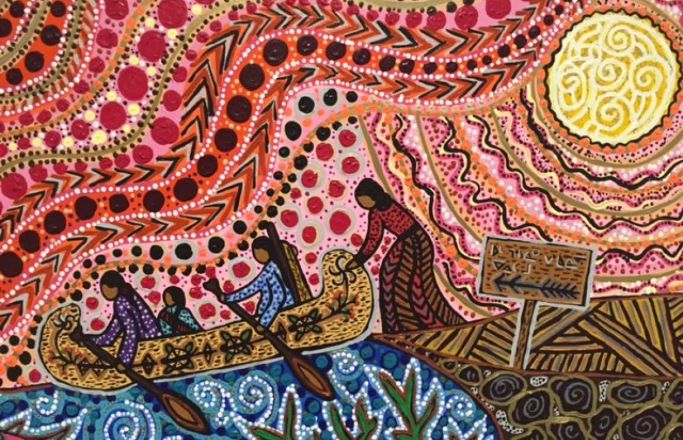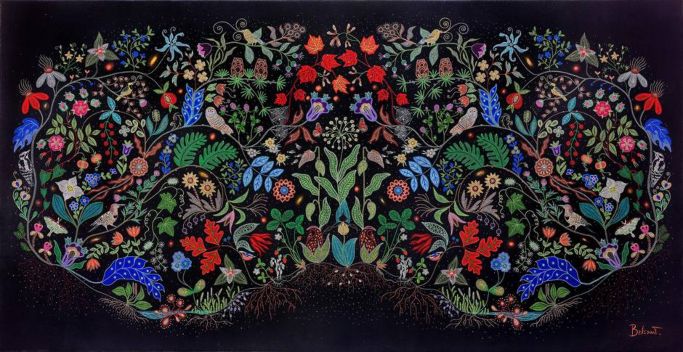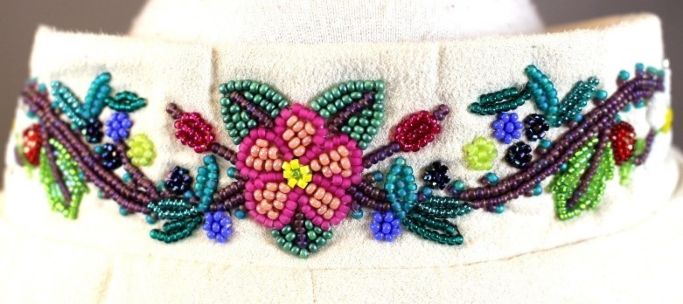Métis artistic expression merges Indigenous and European influences, creating a unique cultural voice. Rather than limiting themselves to single mediums, Métis artists often work across multiple forms, including visual art, music, spoken word, dance, and storytelling.
This artistic practice serves multiple purposes: preserving cultural knowledge, documenting Métis history, and addressing contemporary issues. Artists incorporate traditional elements like floral beadwork patterns and Indigenous languages while embracing modern formats and technologies – creating works that honour heritage while speaking to current realities. In recent years, some Métis artists have started collaborating with online platforms, including online casinos, bringing their unique artistic style to digital spaces.
Métis Artists Crafting Visuals for Casino Platforms
As online casinos expand, there is a growing demand for culturally rich and visually appealing designs. These artists, known for their intricate beadwork-inspired paintings and storytelling through visuals, have begun contributing artwork for casino themes, backgrounds, and promotional materials. Their efforts bring Indigenous culture into the digital gambling scene, creating richer gaming moments. Métis artists are gaining ground as the most trusted online casino sites for Canadians offering dominant online recreation outlets weave these designs into game interfaces, branding, and special events, spotlighting their creativity worldwide. It’s a beautiful marriage of heritage and modern play.
| Feature | Artistic Input | Player Benefit |
|---|---|---|
| Game Interfaces | Beadwork-style buttons | Intuitive and eye-catching |
| Promotional Art | Visuals tied to Indigenous tales | Memorable campaigns |
| Event Designs | Seasonal cultural motifs | Deeper engagement |
Métis creativity extends beyond digital collaborations, with many artists also using their work to educate and inspire. One such artist is Moe Clark, whose voice and artistic expression play a key role in Métis cultural preservation.
Moe Clark: A Voice for Métis Culture

Moe Clark is a Métis multidisciplinary artist who combines spoken word poetry, musical composition, and performance art. Known as a “looping pedal mistress,” she creates layered vocal performances that blend traditional Indigenous elements with contemporary sound technologies.
Her artistic approach draws from oral storytelling traditions, circle singing practices, and Indigenous perspectives on sound and voice. Clark has trained with notable artists, including Rhiannon (from Bobby McFerrin’s Voicestra) and Pura Fé (Ulali), developing a style that incorporates soul, gospel, folk, and spoken word influences.
Her Work and Growth
Clark has evolved from a promising emerging artist to an internationally recognized performer. Her career spans national and international stages in Canada, Belgium, and Brazil.
Key projects include:
- Director of the 10th Annual Canadian Festival of Spoken Word (2013)
- “Bird Messengers” theatre performance with Émilie Monnet
- “It Is Only Sound that Remains” sound theatre with Shahrzad Arshadi
- “Back to Where My Heart Belongs” Cree language songwriting project
This last collaboration with Joseph Naytowhow and Cheryl L’Hirondelle highlights Clark’s commitment to language revitalization. The project involved gathering in Saskatchewan during the Medicine Picking Moon to co-write five songs in nēhiyawēwin (Plains Cree), connecting with elders to understand place names, migration history, and cultural relationships.
Awards and Recognition
Moe Clark has received significant recognition for her artistic contributions. Her videopoem “Intersecting Circles” (2009) became part of the permanent collection at the Peace River Museum, Archives and Mackenzie Centre.
She has delivered featured talks at TedXMontreal (2012) and performed for the Canadian Olympic Team at the London Summer Games (2012). Notable performances include appearances at Maelström ReÉvolution Poétique Fiéstival in Belgium, the word for the festival in Michif being “fiistawiy’n,” and IDEA World Congress: Art for Social Change in Brazil.
In 2014, Moe Clark was named “Poet of Honour” for the Canadian Festival of Spoken Word, confirming her status as a leading voice in contemporary Indigenous spoken word poetry.
Music and Albums by Moe Clark
Clark’s discography shows her evolution as a musician and poet. Her debut album “Circle of She: Story & Song” (2008) established her unique approach to blending spoken word and music.
Her sophomore release, “Within” (2014), expanded her musical vocabulary by incorporating jazz, Persian, choral, and gospel influences. Moe new album is reportedly in development, drawing from her recent collaborations with orchestras and Indigenous language keepers. The album is structured around themes:
| Theme | Description | Featured Songs |
|---|---|---|
| Invocation | Pieces that draw parallels to ceremony through gospel and trance-like vocals | “I Find Grace,” “I Am,” “Calling” |
| Sensual Connection | Works that explore connection to earth’s energy | “Journey to the Core,” “I Give” |
| Poetic Odes | Tributes honoring influential women | “Butterfly Ashes,” “Frida,” “It Is Only Sound that Remains” |
Collaborators on “Within” included Bean Trio, Amir Amiri, monk.e, and other musicians, creating a rich tapestry of sound that supports Clark’s poetry and vocals.
Teaching and Community Work
Clark’s commitment to education and community building is central to her practice. She facilitates workshops on writing, spoken word performance, and looping pedal techniques in schools and communities, with a focus on working with Aboriginal youth.
Her teaching approach aims to “de-habitualize speech” and deepen personal and collective expression. Workshop topics include:
- “Voicing the Earth Body” – narrative voice and sound creation
- “Looping Landscapes” – spoken word and looping pedal techniques
- “Speak!Up MTL Youth Spoken Word” – writing and performance for youth
- “Finding Breath, Circle Singing” – vocal improvisation and group sound-making
In 2010, she served as Leonard Cohen Poet in Residence at Westmount High School and has worked with the Quebec Writers’ Federation. Her teaching methodology draws from talking circle traditions, using microphones as contemporary “talking sticks” to engage youth through technology.
Other Métis Artists to Know
Leah Marie Dorion: Painting Métis Stories

Leah Marie Dorion is an interdisciplinary Métis artist from Prince Albert, Saskatchewan working as a painter, filmmaker, writer, and educator. Her tactile, multi-dimensional paintings incorporate beads, birch bark, and natural elements to honour First Nations and Métis women’s ancestors.
As an author-illustrator, she created children’s books, including “The Giving Tree” (2009), “Relatives With Roots” (2011), and “The Diamond Willow Walking Stick” (2012), that teach Métis values like generosity and connection to the land. Dorion also creates educational murals and facilitates workshops on Métis cultural practices and plant knowledge.
Zoey Roy: Poetry, Rap, and Teaching

Zoey Roy (Nêhithaw-Denesuline Métis) fuses spoken word, hip-hop, and education to empower Indigenous youth. A member of Peter Ballantyne Cree Nation, she has performed internationally, including orchestral collaborations with the Regina and Saskatoon Symphony Orchestras.
Her community work includes Sound Scholars – writing songs with students across Ontario – and Medicine Songs, where Indigenous grandmothers create rap songs. Living with c-PTSD and ADHD herself, Roy credits poetry as vital to her well-being.
With degrees in Education and Public Policy, her honours include the Queen Diamond Jubilee Medal (2012), the Indspire Award (2015), and Ontario’s Arts Educator of the Year (2024).
Christi Belcourt: Painting with Meaning

Christi Belcourt creates internationally acclaimed paintings inspired by traditional Métis beadwork. Using meticulous dot techniques, she depicts medicinal plants and natural elements with environmental messages.
“I’m not simply transferring beadwork patterns onto the canvas; there has to be meaning behind it,” Belcourt explains. Her activism includes co-organizing “Walking With Our Sisters” (2012-2021), commemorating murdered and missing Indigenous women, and establishing Nimkii Aazhibikong, a land-based arts space.
Her works appear in the National Gallery of Canada, the Art Gallery of Ontario, and the Minneapolis Institute of Art. Recent honours include the Order of Canada (2024), being featured on a Canadian stamp, and receiving the Order of Gabriel Dumont.
Lisa Shepherd: Beadwork and Métis Fashion

Lisa Shepherd has established herself as a premier Métis beadwork artist and knowledge carrier since 2008. Her “Art to Wear” clothing line translates traditional beadwork onto modern fashion items, with collections like “lii bufloo,” “Koshkonâ,” and “Padula” appearing on scarves, ties, and garments.
Shepherd addresses cultural appreciation versus appropriation, noting that supporting Indigenous artists is “one of many ways to be a good ally.” As an educator, she leads beadwork workshops, hosts the “Beading Together” podcast, and created “Bannock & Oatmeal,” a theatrical dance piece exploring Métis identity.
Her work appears in institutions including the Royal Ontario Museum, Royal Alberta Museum, and Fort Langley National Historic Site.
What’s Next for Métis Art?
The future of Métis art and aboriginal poetry pulse with momentum as artists break boundaries between tradition and innovation. Digital platforms now amplify voices once limited to local audiences – Clark’s looping compositions stream globally, Belcourt’s paintings reach audiences through social media, and Shepherd’s beadwork inspires fashion lines.
Next-generation Métis creators are already emerging: poet Jessica Johns explores Indigenous futurism, musician Celeigh Cardinal fuses blues with Métis storytelling and visual artist Katherine Boyer transforms architectural space through traditional materials.
Major institutions have taken notice. The inclusion of Métis art in the National Gallery of Canada, international fashion collaborations, and appearances at global cultural events like the World Expo signal a significant shift in recognition.
Perhaps most powerful is the transfer of knowledge happening in communities. Virtual beading circles connect isolated artists, elder-youth partnerships preserve endangered techniques, and land-based studios like Nimkii Aazhibikong create spaces where artistic practice and language revival happen simultaneously.
These artists aren’t just making beautiful objects – they’re forging cultural resilience. As Moe Clark puts it: “Our art documents our story, and our stories ensure our survival.”